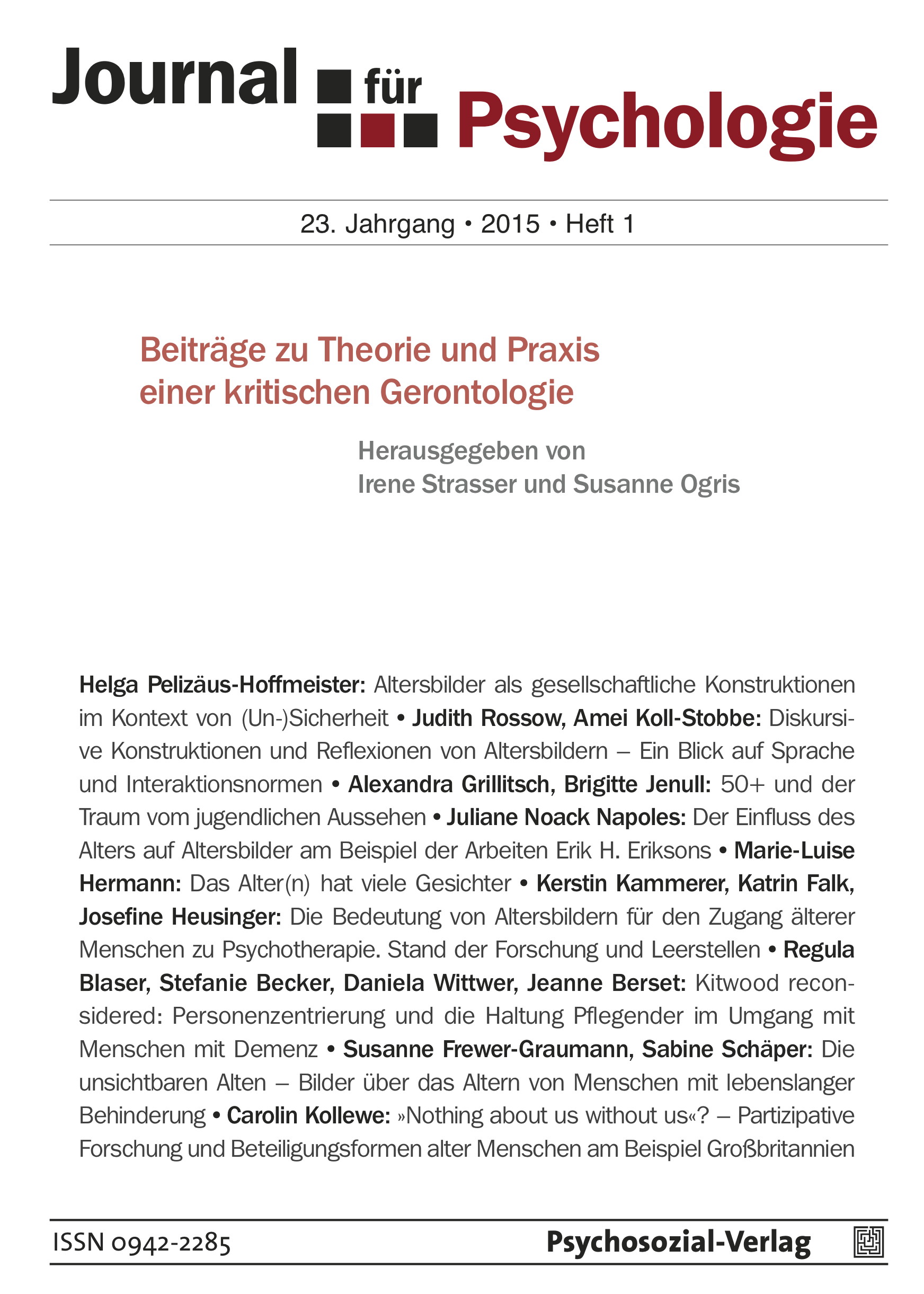Discursive Constructions and Reflections of Images of Ageing in Language and Interaction
Keywords:
images of aging, metonymy, conversation, intergenerational, compliments, politeness, identityAbstract
This paper tries to demonstrate the changing facets of age-constructions and -identities in verbal interactions, and seeks to trace the (re-)productions of age as a culturally anchored conceptual category with fuzzy edges. The variability and flexibility of the concept of age will first be explained with the help of a semantic analysis of the lexemes’ antonymy. Addressing age-related compliments, the second part expands on this by analyzing the different roles images of ageing play in interactive verbal routines.
References
Baltes, Margret M.; Wahl, Hans-Werner (1996). Patterns of communication in old age: the dependence-support und independence-ignore script. Health Communication, 8 (3), 217–231.
Bayraktaroǧlu, Arin (1992). Politeness and interactional imbalance. In: Coulmas, Florian (Hrsg.). New Perspectives on linguistic etiquette. International Journal of the Sociology of Language, 92, 5–34.
BMFSFJ (2010). Sechster Bericht zur Lage der älteren Generation in der Bundesrepublik Deutschland: Altersbilder in der Gesellschaft und Stellungnahme der Bundesregierung. Berlin: Deutscher Bundestag.
Bonnefon, Jean-François; Feeney, Aidan; De Neys, Wim (2011). The risk of polite misunderstandings. Current Directions in Psychological Science, 20 (5), 321–324.
Brown, Penelope; Levinson, Stephen C. (1987). Politeness: some universals in language usage. 2., überarbeitete Auflage. Cambridge u.a.: CUP.
Coulmas, Florian (1979). On the sociolinguistic relevance of routine formulae. Journal of Pragmatics, 3, 239–266.
Coupland, Justine; Coupland, Nikolas; Grainger, Karen (1991). Intergenerational discourse: contextual versions of ageing and elderliness. Ageing and Society, 11 (2), 189–208.
Coupland Nikolas; Nussbaum, Jon F. (1993). Discourse and lifespan identity. London: Sage.
Eckert, Penelope (1997). Age as a sociolinguistic variable. In: Coulmas, Florian (Hrsg.). The handbook of sociolinguistics. Oxford: Blackwell, 151–167.
Galato, Andrea (2002). German compliment responses. Journal of Pragmatics, 34, 547–571.
Giles, Howard (1991). ‘Gosh, You Don’t Look It!’: a sociolinguistic construction of ageing. The Psychologist: Bulletin of the British Psychological Society, 3, 99–106.
Giles, Howard; Coupland, Nikolas; Coupland, Justine (1991). Accommodation theory: communication, context, and consequence. In: Giles, Howard; Coupland, Nikolas; Coupland, Justine (Hrsgg.). Contexts of accommodation: developments in applied sociolinguistics. Cambridge: CUP, 1–68.
Giles, Howard; Coupland, Nikolas; Coupland, Justine; Williams, Angie; Nussbaum, Jon (1992). Intergenerational talk and communication with older people. International Journal of Aging and Human Development, 34 (4), 271–297.
Goffman, Erving (1971). Interaktionsrituale: Über Verhalten in direkter Kommunikation. 2. Auflage. Frankfurt/Main: Suhrkamp.
Goffman, Erving (2003). On face-work: an analysis of ritual elements in social interaction. Reflections, 4 (3), 7–13.
Hamilton, Heidi (2001). Discourse and aging. In: Schiffrin, Deborah; Tannen, Deborah; Hamilton, Heidi (Hrsgg.). The handbook of discourse analysis. Oxford: Blackwell, 568–589.
Hummert, Mary Lee; Garstka, Teri A.; Ryan, Ellen B.; Bonnesen, Jaye L. (2008). The role of age stereotypes in interpersonal communication. In: Nussbaum, Jon F.; Coupland, Justine (Hrsgg.). Handbook of communication and aging research. Second edition. New York: Routledge, 91–114.
Koll-Stobbe, Amei (2000). Konkrete Lexikologie. Entwurf einer Theorie des Sprachkönnens. Tübingen: Niemeyer. (Nachdruck: 2010, Berlin: Mouton de Gruyter).
Koll-Stobbe, Amei (2005). Forever Young? Sprachliche Kodierungen von Jugend und Alter. In: Hartung, Heike (Hrsg.). Alter und Geschlecht. Repräsentationen, Geschichten und Theorien des Alter(n)s. Bielefeld: Transcript, 237–252.
Lambert, Margitta (1998). Zu unterschiedlichen Realisierungen des Komplimentmusters in Altentagesstätten- bzw. Heimkommunikation. In: Fiehler, Reinhard; Thimm, Caja (Hrsgg.). Sprache und Kommunikation im Alter. Opladen/Wiesbaden: Westdeutscher Verlag, 161-174.
La Tourette, Tammi R.; Suzanne Meeks (2000). Perceptions of patronizing speech by older women in nursing homes and in the community: impact of cognitive ability and place of residence. Journal of Language and Social Psychology, 19 (4), 463–473.
Lehr, Ursula (2007). Psychologie des Alterns. 11. Auflage. Wiebelsheim: Quelle & Meyer Verlag.
Lessenich, Stephan (2014). Zur Neuverhandlung des Alters in der Aktivgesellschaft. Forschung & Lehre, 21 (6), 424–425.
Linke, Angelika (1998). Sprache, Gesellschaft und Geschichte: Überlegungen zur symbolischen Funktion kommunikativer Praktiken der Distanz. Zeitschrift für Germanistische Linguistik, 26 (2), 135–154.
Rossow, Judith (2008). Alterskomplimente und negative Altersbilder. Informationsdienst Altersfragen, 35 (4), 11–14.
Rossow, Judith (2013). New contexts and new concepts: the use of German ‚alt‘. In: Bieswanger, Markus; Koll-Stobbe, Amei (Hrsgg.). New approaches to the study of linguistic variability. Frankfurt/Main: Peter Lang, 117–138.
Ryan, Ellen B.; Kwong See, Sheree T. (1998). Sprache, Kommunikation und Altern. In: Fiehler, Reinhard; Thimm, Caja (Hrsgg.). Sprache und Kommunikation im Alter. Opladen/Wiesbaden: Westdeutscher Verlag, 57–71.
Sachweh, Svenja (1998). ‚so frau adams↓ guck mal↓ ein feines bac-spray↓ gut↑‘ Charakteristische Merkmale der Kommunikation zwischen Pflegepersonal und BewohnerInnen in der Altenpflege. In: Fiehler, Reinhard; Thimm, Caja (Hrsgg.). Sprache und Kommunikation im Alter. Opladen/Wiesbaden: Westdeutscher Verlag, 143–160.
Stilwell Peccei, Jean (2004). Language and age. In: Thomas, Linda; Singh, Ishtla; Stilwell Peccei, Jean (Hrsgg.). Language, Society and Power. Abingdon Oxen: Routledge, 114–131.
Thimm, Caja (2000). Alter – Sprache – Geschlecht: Sprach- und kommunikationswissenschaftliche Perspektiven auf das höhere Lebensalter. Frankfurt/Main: Campus.
Thimm, Caja (2002). Alter als Kommunikationsproblem? Eine exemplarische Analyse von Gesprächsstrategien in intergenerationeller Kommunikation. In: Fiehler, Reihard (Hrsg.). Verständigungsprobleme und gestörte Kommunikation. Radolfzell: Verlag für Gesprächsforschung, 177–197.
Weiner, Edmund S. C.; Simpson, John A. (Hrsgg.) (1991). The Compact Oxford English Dictionary (OED). 2. Auflage. Oxford: Oxford University Press.
Downloads
Published
How to Cite
Issue
Section
License
This license allows private use and unmodified distribution, but prohibits editing and commercial use (further information can be found at: https://creativecommons.org/licenses/by-nc-nd/4.0/).
The terms of the Creative Commons licence only apply to the original material. The reuse of material from other sources (marked with a reference) such as charts, illustrations, photos and text extracts may require further permission for use from the respective copyrights holder.



